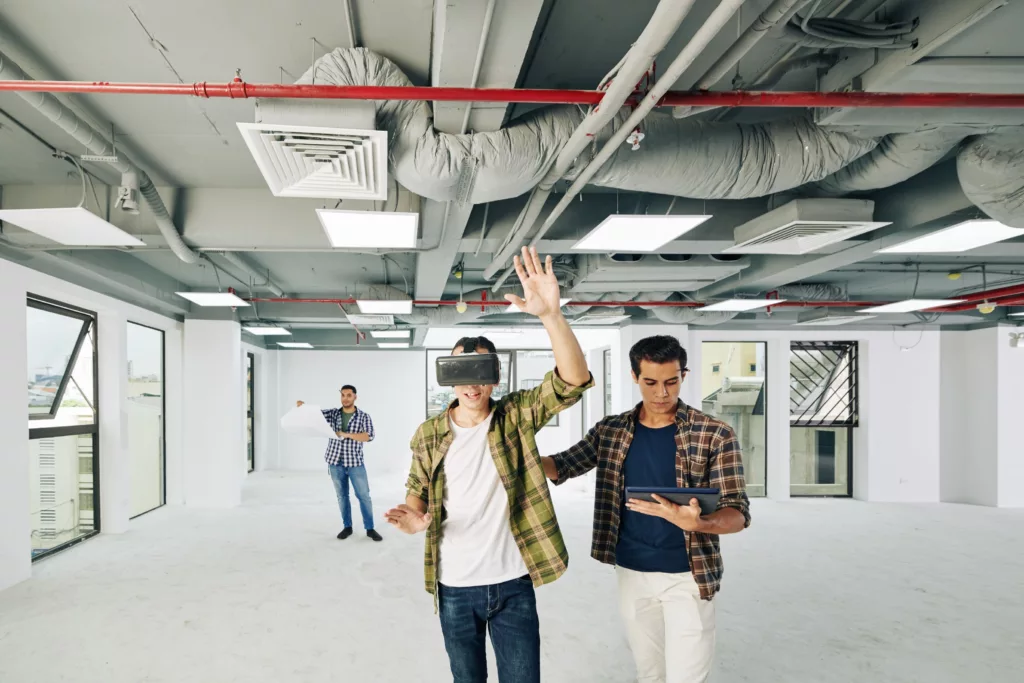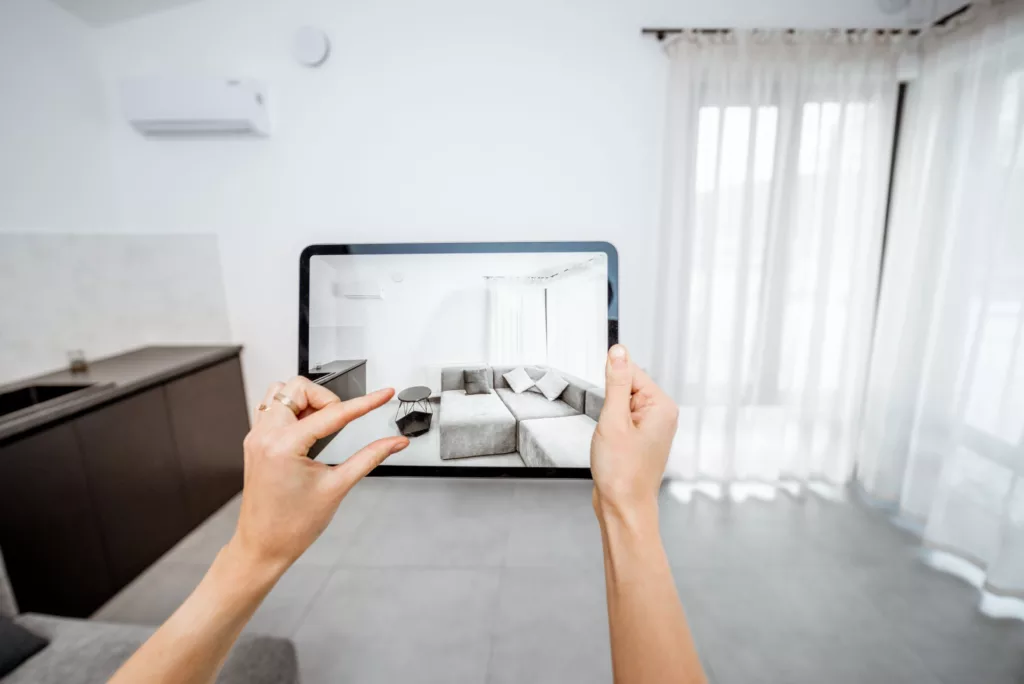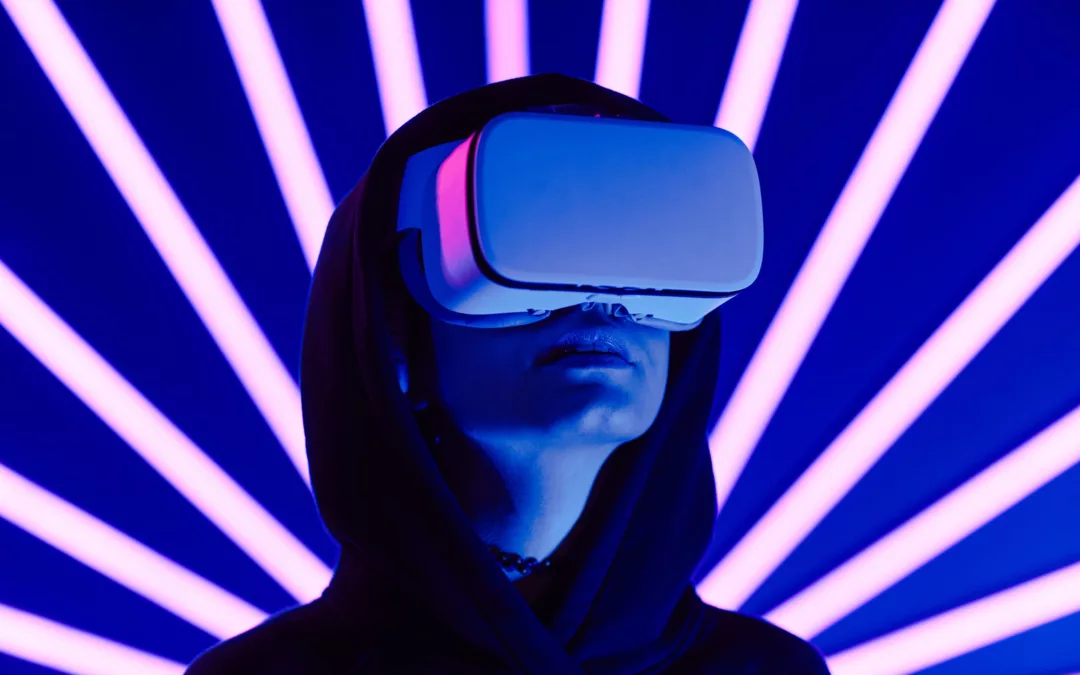When you hear the terms “augmented reality” (AR) or “virtual reality” (VR), you may immediately think of immersive video games or movies like Tron or Minority Report. But did you know that these technologies are used in interior design to deliver an impressive, fully visualized experience for interior designers and their clients? AR and VR are fast becoming invaluable tools for visualization throughout the design process as both technologies support the collaborative process between architects, interior designers, and clients.
The Differences Between Augmented Reality and Virtual Reality
Virtual reality (VR) simulates a stand-alone world. To interact with it, one needs specific devices that are transmitting human movements and affecting one’s senses. A VR helmet or glasses are most often among them.
Augmented reality (AR) is easier to work with. That is the real world, supplemented by virtual elements “expanding” or “enriching” it.
Using this technology, hard changes to the interior of a building or home become engaging and exciting to do. When augmented reality is used in interior design, it allows interior designers to try new furniture and accessories in the living room. As well, one can find out the size of the room or even see how posters and wall art will look in place on the walls.

How Architects and Designers Use Virtual Reality
Architects and home designers use 2D drawings to communicate their ideas with their team and their clients. Interpreting 2D drawings, however, can be difficult for many people especially if there is no reference points for them to use. Until recently, many in the design industry attempted to solve this puzzle by creating 3D renderings and architectural models to scale.
While 3D representations help with visualization, they are not foolproof without immersion. Some people will have difficulty understanding the scale of a space or its furnishings. And this is one of the reasons why VR and AR are exciting solutions for home/Interior designers and architects alike.
Architects use virtual reality to bring their floor plans and 3D renderings to life in order for their clients to feel as if they are in the redesigned space before the project has commenced.
In an article on virtual reality from Architectural Digest, David Alhadeff, founder of The Future Perfect, said this: “A lot of our architecture and interior design clients are taking this idea [of using virtual reality as a selling tool] and bringing it into a hypothetical reality for a space they’re creating for their client and, to me, that seems better than the past where you might have signed off on an idea with a designer based on a drawing. This way, you can get a window into your future space.”
We agree.

How Do AR and VR Benefit Interior Designers
The benefits are many… These technologies make it easier to engage stakeholders and homeowners to aid in clarifying abstract concepts. But they also improve the way architects and design teams work together.
In the article, “Augmented Reality for Interior Design: Key-Value Propositions Paving the Way for a Revolution,” Tuhin Bhatt posits, “By simply allowing the customers to stay on the same page with the designers, the sellers and designers can garner better satisfaction and ensure better project delivery. AR-based presentations also allow better iterations in an ongoing design project and ensure better outcomes by syncing expectations on both ends.”
Using this technology will ultimately save time and frustration for everyone involved in a design project, despite its inherent learning curve. In the article, “What Virtual Reality Brings to Interior Design,” the author observes, “VR can be a time-saver in the initial stages of a project. Showing clients a design this way can avoid the need for lengthy explanations as part of a presentation because they can actually see what you’re talking about.”
There are also these other benefits that add tremendous value to both the client and the designer.
facilitated communication
When used properly, these modern technologies can absolutely reduce the time required to coordinate the project and facilitate communication while discussing all the details. AR provides the opportunity to learn more about the product and its possible customizations. That allows you, the consumer, to get a deeper understanding of your potential purchase and increase your confidence in the final decision made.
Decreased Merchandise Returns
Nothing is more tedious and frustrating during the design process than having to return furniture and merchandise due to an unrealized understanding of its look and feel in the staged environment. Using AR as an efficient tool for optimizing processes, our designers and clients alike reduce the merchandise return risks and avoid excess costs by having an understanding of how it feels before ordering it.
Accelerated Project Pace
Having the possibility to look at the product before buying it leaves you, the client, more confident in making decisions about paying for the product. Our Designers do not have to explain anything for a long time, as they can just show everything to our clients. Therefore, while previously, discussing concepts could have taken a week to clarify details necessary for decision-making, just a few hours of talk may suffice now.
Our Final Thoughts
While virtual and augmented reality are both new and exciting technologies, they are not fads. These technologies are increasingly valuable for the design industry to communicate a design within a team and to our clients more effectively. Contact Tiffany Hanken Design today to have a discussion about how you can implement AR and VR into your home design project.

